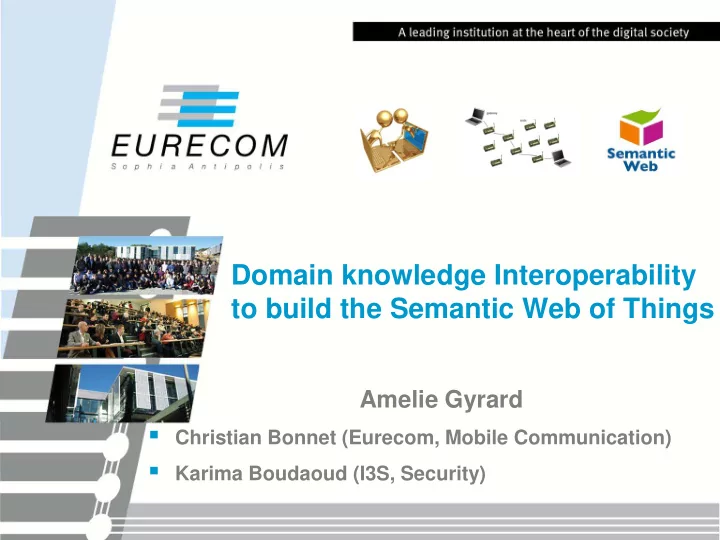

Domain knowledge Interoperability to build the Semantic Web of Things Amelie Gyrard Christian Bonnet (Eurecom, Mobile Communication) Karima Boudaoud (I3S, Security)
Motivation How to help developers to design IoT applications? How to combine domains? How to reuse domain knowledge? How to reason on sensor data? - p 2
The M3 ontology (Machine to Machine Measurement) SenML protocol [draft-jennings-senml-10] Extension of the W3C Semantic Sensor Networks (SSN) ontology (Observation Value concept) Do not provide a basis for reasoning that can ease the development of advanced applications Classify all the concepts in the Machine-to-Machine (M3) ontology Domain (health, smart building, weather, room, city, etc.) Measurement type (t = temp = temperature) Sensor type (rainfall sensor = precipitation sensor) Standardize sensors, measurements and domain terms? - p 3
How to deduce new knowledge? Rules example: If Domain == Health && MeasurementType == Temperature then NewType = BodyTemperature If BodyTemperature > 39°C then “ Fever ” BodyTemperature and Fever are already described in domain ontologies or datasets! More than 200 ontology-based IoT applications are referenced: Difficulties to automate knowledge extraction – Lack of semantic web best practices [OneM2M, Gyrard 2014] – Heterogeneous terms used (e.g., etymology, synonyms) Standardize sensor-based domain ontologies? – As it has been done for W3C SSN, W3C Time or Schema.org OneM2M, Working Group 5 (Management, Abstraction and Semantics) - p 4 OneM2M Semantic Web Best practices [Gyrard et al. 2014]
http://www.sensormeasurement.appspot.com/?p=ontologies - p 5
Sensor-based Linked Open rules We propose the Linked Open Rules Heterogeneous formats (ontology editor tool, inference engine, etc.) http://www.sensormeasurement.appspot.com/?p=swot_template - p 6
Scenario 1: Body Temperature Reason on M2M Data http://sensormeasurement.appspot.com/ Linked Open Data Linked Open Rules Paper: Honey as Complementary Medicine - A Review [Singh et al. 2012] - p 7
Scenario 2: Weather Temperature & Luminosity Paper: Mapping emotion to color [Nijdam 2009] - p 8 “Seasonal affective disorder”
SWoT framework (Semantic Web of Things) To help developers to build IoT applications: Reason on sensor data Build interoperable IoT applications Easily combine domains Reuse domain knowledge - p 9
Conclusion & Future works Standardization suggestions: OneM2M, ETSI M2M, W3C Web of Things, W3C SSN Semantic web best practices Sensor measurements in a unified way Linked Open Rules Sensor-based domain ontologies - p 10
Thank you! We are looking for new real-use case scenarios gyrard@eurecom.fr http://sensormeasurement.appspot.com/ - p 11
Recommend
More recommend